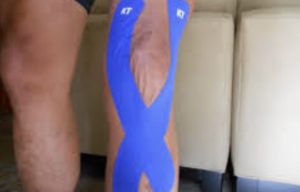

. 2016 Sep;44(3):252-6.
doi: 10.1080/00913847.2016.1199251. Epub 2016 Jun 22.
Effects of kinesiotaping versus non-steroidal anti-inflammatory drugs and physical therapy for treatment of pes anserinus tendino-bursitis: A randomized comparative clinical trial
- PMID: 27276165
- DOI: 10.1080/00913847.2016.1199251
Abstract
Objective: Pes anserinus tendino-bursitis is a condition caused by repetitive friction over the bursa or direct trauma to knee joint and it presents with proximal medial tibial pain and swelling. The aim of this study is to determine the effects of kinesiotaping in comparison with naproxen and physical therapy in treatment of pes anserinus tendino-bursitis.
Methods: In a randomized comparative clinical trial 56 patients with clinical diagnosis of pes anserinus tendino-bursitis were randomly assigned to kinesiotaping and naproxen/physical therapy (28 patients in each group). Kinesiotaping on the tender area in the form of space-correction (lifting) technique was used and repeated for three times with a one-week interval. Another group received naproxen (250mg TID for 10 days) and ten sessions of daily physical therapy. The visual analog scale (VAS) was used for evaluation of pain. The depth of swelling of the area was measured with sonography before and after treatment. Wilcoxon signed ranks test has been used for determining the influence of interventions on pain (VAS) and swelling scores in each group. The ANCOVA (Analysis of covariance) test was applied for comparing the influence of interventions on VAS and swelling scores after adjustment for co-variables.
Results: At end of the study, 27 patients remained in the kinesiotaping group and 19 patients in naproxen/physical therapy group. Treatment with kinesiotaping significantly decreased the pain (P=0.0001) and swelling scores (P=0.0001) in comparison with naproxen/physical therapy after adjustment for baseline characteristics. Kinesiotaping was safe without any complications except for a mild local skin irritation in one patient.
Conclusion: Kinesiotaping is more effective than naproxen plus physical therapy in reduction of pain and swelling in patients with pes anserinus tendino-bursitis.
Clinical trial registration: www.ClinicalTrials.gov identifier is NCT01680263.
Keywords: Athletic tape; bursitis; knee joint; sports medicine; tendinopathy.
CORE Omaha Physical Therapy Explains…
By Dr. Mark Rathjen PT DPT CSCS
CORE Physical Therapy and Sports Performance PC,
est 2015 Omaha, Ne
This study states “Treatment with kinesiotaping significantly decreased the pain (P=0.0001) and swelling scores (P=0.0001) in comparison with naproxen/physical therapy after adjustment for baseline characteristics. Kinesiotaping was safe without any complications except for a mild local skin irritation in one patient.”
What does this mean?
Kineso taping (KT) for knee pain, especially Pes anserine bursitis has been shown to be more effective in controlling pain and recovery compared to NSAIDs alone. This study sample size was small at 27, and although very significant findings were found, we must be sure to know the small power of the study. That being said, in this population, it was EFFECTIVE. We must not discount this fact.
We have also seen that KT taping can also be effective for patellar tendonitis as well. The mechanism is likely to be proprioceptive in nature, and the increased awareness and muscle activation will decrease stress and strain on the effected joint. More over, taping effectively does take time and experience. We have seen in other studies that the type of taping and method of application is the key to good overall results. Other studies have shown being more specific in the technique isn’t always necessary to good results.
KT taping can be part of a full spectrum care to help eliminate the mechanical issues to rid the body of a tendonopathy. Proper movement symmetry, proper strength symmetry and hip stabilization, proper core stabilization and full programming and activities modification can be a huge part of fixing the issue. Modalities as dry needling, graston, and KT taping can accelerate the healing and decrease of symptoms. This allows the Doctors of Physical Therapy to fully fix and divide a plan to fix the root of the issue.
Core Physical Therapy and Sports Performance in Omaha Nebraska was establish in 2015. We specialize in science based treatment of athletes by elite Doctors of Physical Therapy. Our clinicians are the best in the Omaha Metro Area.
C.O.R.E. Physical Therapy and Sports Performance PC,
17660 Wright St, Suites 9/10
Omaha, NE 68130
402-930-4027
At CORE Physical Therapy in Omaha, we specialize in the treatment of athletes. We have worked with athletes for a combined 30 years.
This is who are, This is what we do.
Owned and Operated
by
Dr. Mark Rathjen and Dr. Claire Rathjen.
CORE is a family owned business
est. 2015
We are proud to serve the greater Omaha metro area.
For More information, Please feel free to contact us https://coreomaha.com/contact/
Please feel free to follow us at https://www.facebook.com/COREomaha/
To get started https://coreomaha.com/getting-started/
For more Blog information https://coreomaha.com/blog/
Youtube Account linked below.
https://www.youtube.com/channel/UCVg8OSN5h-i1n_ykw1Gvahg?view_as=subscriber
Similar articles
-
Phys Sportsmed. 2016 Nov;44(4):342. doi: 10.1080/00913847.2016.1230467. Epub 2016 Sep 8.PMID: 27589878 Clinical Trial. No abstract available.
-
Mod Rheumatol. 2015 Jan;25(1):128-33. doi: 10.3109/14397595.2014.931909. Epub 2014 Jul 18.PMID: 25036227
-
Pes anserinus tendino-bursitis: what are we talking about?
Scand J Rheumatol. 2000;29(3):184-6. doi: 10.1080/030097400750002076.PMID: 10898072 -
Rev Bras Reumatol. 2010 May-Jun;50(3):313-27.PMID: 21125167 Review. English, Portuguese.
-
Med Clin North Am. 2014 Mar;98(2):331-8. doi: 10.1016/j.mcna.2013.11.005.PMID:24559878 Review.

